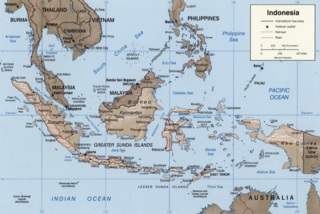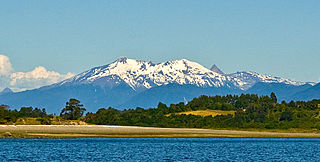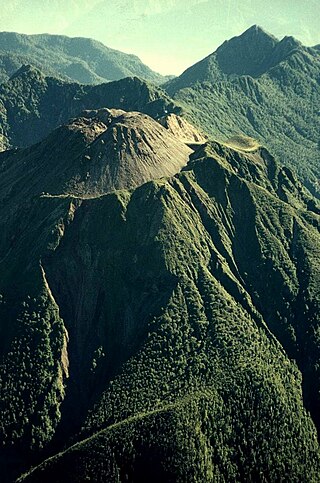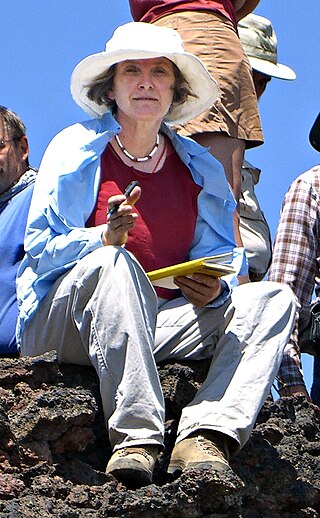
Eldgjá is a volcano and a canyon in Iceland. Eldgjá is part of the Katla volcano; it is a segment of a 40 kilometres (25 mi) long chain of volcanic craters and fissure vents that extends northeast away from Katla volcano almost to the Vatnajökull ice cap. This fissure experienced a major eruption around 939 CE, which was the largest effusive eruption in recent history. It covered about 780 square kilometres (300 sq mi) of land with 18.6 cubic kilometres (4.5 cu mi) of lava from two major lava flows.

Santa María Volcano is a large active volcano in the western highlands of Guatemala, in the Quetzaltenango Department near the city of Quetzaltenango. It is part of the mountain range of the Sierra Madre.

The Sunda Arc is a volcanic arc that produced the volcanoes that form the topographic spine of the islands of Sumatra, Nusa Tenggara, Java, the Sunda Strait, and the Lesser Sunda Islands. The Sunda Arc begins at Sumatra and ends at Flores, and is adjacent to the Banda Arc. The Sunda Arc is formed via the subduction of the Indo-Australian Plate beneath the Sunda and Burma plates at a velocity of 63–70 mm/year.

Yate Volcano is a large, glaciated stratovolcano located in the southern Andes, in the Los Lagos Region of Chile, south of the Reloncaví Estuary. Yate lies on the major regional Liquiñe-Ofqui Fault Zone, and is located 10 km north-east of the smaller Hornopiren volcano. The last known eruption occurred in 1090 CE. There are no historical records of recent volcanic activity, but there is strategic evidence of smaller eruptions sometime in the Holocene. The volcano is named after Juan Yates, also known as John Yates, a settler of Puerto Americano who played a significant role in the exploration and colonisation of Patagonia.

The East Australia hotspot is a volcanic province in southeast Australia which includes the Peak Range in central Queensland, the Main Range on the Queensland-New South Wales border, Tweed Volcano in New South Wales, and the Newer Volcanics Province (NVP) in Victoria and South Australia. A number of the volcanoes in the province have erupted since Aboriginal settlement. The most recent eruptions were about 5,600 years ago, and memories of them survive in Aboriginal folklore. These eruptions formed the volcanoes Mount Schank and Mount Gambier in the NVP. There have been no eruptions on the Australian mainland since European settlement.

Yanteles is an isolated stratovolcano composed of five glacier-capped peaks along an 8 km-long NE-trending ridge. It is located approximately 30 km (19 mi) south of the Corcovado volcano in the Chilean X Region within the Corcovado National Park. The name Yanteles can refer only to the main summit, which is also known as Volcán Nevado.
Mentolat is an ice-filled, 6 km (4 mi) wide caldera in the central portion of Magdalena Island, Aisén Province, Chilean Patagonia. This caldera sits on top of a stratovolcano which has generated lava flows and pyroclastic flows. The caldera is filled with a glacier.

The surface of Venus is dominated by volcanic features and has more volcanoes than any other planet in the Solar System. It has a surface that is 90% basalt, and about 65% of the planet consists of a mosaic of volcanic lava plains, indicating that volcanism played a major role in shaping its surface. There are more than 1,000 volcanic structures and possible periodic resurfacing of Venus by floods of lava. The planet may have had a major global resurfacing event about 500 million years ago, from what scientists can tell from the density of impact craters on the surface. Venus has an atmosphere rich in carbon dioxide, with a pressure that is 90 times that of Earth's atmosphere.
Gillian Rose Foulger is a British geologist and academic born in 1952 in Ipswich. Foulger plays a major role in coordinating the global debate in the category of Earth Science, on whether or not deep mantle thermal plumes exist and create “hot spot” volcanism.

Huequi is a volcano in the Los Lagos Region of Chile. It is in the Southern Volcanic Zone, in the centre of Ayacara Peninsula and close to the Gulf of Ancud. It is made up of a lava dome complex situated in a depression of unclear origin, a postglacial lava dome Calle and a Pleistocene volcano with Holocene parasitic cones, with a sharp summit at 1,318 metres (4,324 ft). There were reports of eruptions 1890–1920, and it is said to have "smoked" in 1935.

Volcanic lightning is an electrical discharge caused by a volcanic eruption rather than from an ordinary thunderstorm. Volcanic lightning arises from colliding, fragmenting particles of volcanic ash, which generate static electricity within the volcanic plume, leading to the name dirty thunderstorm. Moist convection currents and ice formation also drive the eruption plume dynamics and can trigger volcanic lightning. Unlike ordinary thunderstorms, volcanic lightning can also occur when there are no ice crystals in the ash cloud.
Derek Keir has been an associate professor of geophysics at the University of Southampton since 2015. In 2013 he received the Bullerwell Lecture award from the British Geophysical Association (BGA) for significant contributions to geophysics.

A multi-component gas analyzer system (Multi-GAS) is an instrument package used to take real-time high-resolution measurements of volcanic gases. A Multi-GAS package includes an infrared spectrometer for CO2, two electrochemical sensors for SO2 and H2S, and pressure–temperature–humidity sensors, all in a weatherproof box. The system can be used for individual surveys or set up as permanent stations connected to radio transmitters for transmission of data from remote locations. The instrument package is portable, and its operation and data analysis are simple enough to be conducted by non-specialists.
Marie Edmonds is a Professor of volcanology and Earth Sciences at the Department of Earth Sciences at the University of Cambridge whose research focuses on the physics and chemistry of volcanic eruptions and magmatism and understanding volatile cycling in the solid Earth as mediated by plate tectonics. She is interested in the social and economic impacts of natural hazards; and the sustainable use of Earth's mineral and energy resources. Professor Edmonds is the Vice President and Ron Oxburgh Fellow in Earth Sciences at Queens' College, Cambridge; and the Deputy Head of Department and Director of Research at the Earth Sciences Department, University of Cambridge.
Clive Oppenheimer is a British volcanologist, and Professor of Volcanology in the Department of Geography of the University of Cambridge.
Jenni Barclay is a professor of volcanology at the University of East Anglia. She works on ways to mitigate volcanic risks, the interactions between rainfall and volcanic activity and the communication of volcanic hazards in the Caribbean. Barclay leads the NERC-ESRC funded Strengthening Resilience to Volcanic Hazards (STREVA) research project as well as a Leverhulme Trust programme looking at the volcanic history of the Ascension Islands.
Intraplate volcanism is volcanism that takes place away from the margins of tectonic plates. Most volcanic activity takes place on plate margins, and there is broad consensus among geologists that this activity is explained well by the theory of plate tectonics. However, the origins of volcanic activity within plates remains controversial.

Anita Lizzie Grunder is geologist known for her research on volcanic rocks and defining changes in volcanism over geologic eras. She is an elected fellow of the Geological Society of America.
Juliet J. Biggs is a British geologist who is Professor of Earth Sciences at the University of Bristol. Her research uses satellite geodesy and interferometric synthetic-aperture radar (InSAR) to understand the physics of the Earth's crust. She was awarded the American Geophysical Union John Wahr Award in 2017 and a European Research Council (ERC) consolidator grant in 2020.











